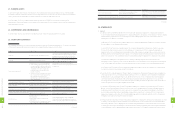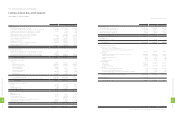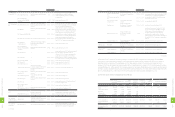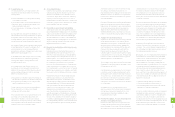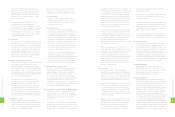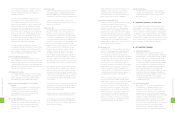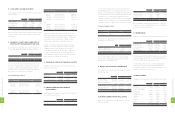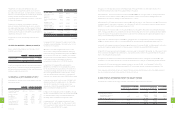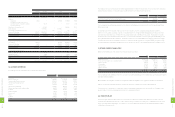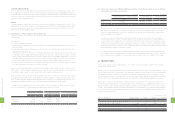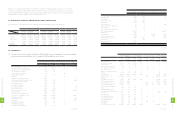HTC 2012 Annual Report Download - page 106
Download and view the complete annual report
Please find page 106 of the 2012 HTC annual report below. You can navigate through the pages in the report by either clicking on the pages listed below, or by using the keyword search tool below to find specific information within the annual report.
A derivative that does not meet the criteria for hedge
accounting is classified as a financial asset or a
financial liability held for trading. If the fair value of the
derivative is positive, the derivative is recognized as a
financial asset; otherwise, the derivative is recognized
as a financial liability.
Fair values of financial assets and financial liabilities at the
balance sheet date are determined as follows: publicly
traded stocks - at closing prices; open-end mutual funds
- at net asset values; bonds - at prices quoted by the
Taiwan GreTai Securities Market; and financial assets
and financial liabilities without quoted prices in an active
market - at values determined using valuation techniques.
(7) Available-for-sale Financial Assets
Available-for-sale financial assets are initially measured
at fair value plus transaction costs that are directly
attributable to the acquisition. At each balance sheet
date subsequent to initial recognition, available-for-
sale financial assets are remeasured at fair value, with
changes in fair value recognized in equity until the
financial assets are disposed of, at which time, the
cumulative gain or loss previously recognized in equity
is included in profit or loss for the year. All regular way
purchases or sales of financial assets are recognized
and derecognized on a trade date basis.
The recognition, derecognition and the fair value bases
of available-for-sale financial assets are similar to those
of financial assets at FVTPL.
Cash dividends are recognized upon the stockholders'
resolutions, except for dividends distributed from the
pre-acquisition profit, which are treated as a reduction
of investment cost. Stock dividends are not recognized
as investment income but are recorded as an increase
in the number of shares. The total number of shares
subsequent to the increase is used for the recalculation
of cost per share.
An impairment loss is recognized when there is
objective evidence that the financial asset is impaired.
Any subsequent decrease in impairment loss on an
equity instrument classified as available-for-sale is
recognized directly in equity.
(8) Revenue Recognition, Accounts Receivable and
Allowance for Doubtful Accounts
Revenue from sales of goods is recognized when the
Company has transferred to the buyer the significant
risks and rewards of ownership of the goods, primarily
upon shipment, because the earnings process has been
completed and the economic benefits associated with
the transaction have been realized or are realizable.
The Company does not recognize sales revenue on
materials delivered to subcontractors because this
delivery does not involve a transfer of risks and rewards
of materials ownership.
Revenue is measured at the fair value of the consideration
received or receivable and represents amounts agreed
between the Company and the customers for goods sold
in the normal course of business, net of sales discounts
and volume rebates. For trade receivables due within
one year from the balance sheet date, as the nominal
value of the consideration to be received approximates
its fair value and transactions are frequent, fair value of
the consideration is not determined by discounting all
future receipts using an imputed rate of interest.
An allowance for doubtful accounts is provided on
the basis of a review of the collectability of accounts
receivable. This review is made by an aging analysis of
the outstanding receivables and assessing the value of
the collaterals provided by customers.
On January 1, 2011, the Company adopted the third-time
revised Statement of Financial Accounting Standards
("SFAS") No. 34 - "Financial Instruments: Recognition
and Measurement." One of the main revisions is
that the impairment of receivables originated by the
Company should be covered by SFAS No. 34. Accounts
receivable are assessed for impairment at the end of
each reporting period and considered impaired when
there is objective evidence that, as a result of one or
more events that occurred after the initial recognition of
the accounts receivable, the estimated future cash flows
of the asset have been affected. Objective evidence of
impairment could include:
• Significant financial difficulty of the debtor;
• Accounts receivable becoming overdue; or
• It becoming probable that the debtor will undergo
bankruptcy or financial reorganization.
Accounts receivable that are assessed as not impaired
individually are further assessed for impairment on a
collective basis. Objective evidence of impairment for
a portfolio of accounts receivable could include the
Company's past experience of collecting payments and
an increase in the number of delayed payments, as well
as observable changes in national or local economic
conditions that correlate with defaults on receivables.
(3) Foreign Currencies
The financial statements of foreign operations are
translated into New Taiwan dollars at the following
exchange rates:
a. Assets and liabilities - at exchange rates prevailing
on the balance sheet date;
b. Stockholders' equity - at historical exchange rates;
c. Dividends - at the exchange rate prevailing on the
dividend declaration date; and
d. Income and expenses - at average exchange rates
for the year.
Exchange differences arising from the translation of the
financial statements of foreign operations are recognized
as a separate component of stockholders' equity. These
exchange differences are recognized as gain or loss in
the year in which the foreign operations are disposed of.
Non-derivative foreign-currency transactions are recorded
in New Taiwan dollars at the rates of exchange in effect
when the transactions occur. Exchange differences
arising from the settlement of foreign-currency assets and
liabilities are recognized as gain or loss.
At the balance sheet date, foreign-currency monetary
assets and liabilities are revalued using prevailing
exchange rates and the exchange differences are
recognized in profit or loss.
At the balance sheet date, foreign-currency non-
monetary assets (such as equity instruments) and
liabilities that are measured at fair value are revalued
using prevailing exchange rates, with the exchange
differences treated as follows:
a. Recognized in stockholders' equity if the changes in
fair value are recognized in stockholders' equity; and
b. Recognized in profit and loss if the changes in fair
value is recognized in profit or loss.
Foreign-currency non-monetary assets and liabilities
that are carried at cost continue to be stated at
exchange rates at the trade dates.
If the functional currency of an equity-method investee
is a foreign currency, translation adjustments will
result from the translation of the investee's financial
statements into the reporting currency of the Company.
These adjustments are accumulated and reported as a
separate component of stockholders' equity.
(4) Accounting Estimates
Under the above guidelines, law and principles, certain
estimates and assumptions have been used for the
allowance for doubtful accounts, allowance for loss
on inventories, depreciation of properties, marketing
expenses, income tax, royalty, pension cost, loss on
pending litigations, product warranties, contingent loss
on purchase order, bonuses to employees, etc. Actual
results may differ from these estimates.
(5) Current/Non-current Assets and Liabilities
Current assets include cash, cash equivalents, and those
assets held primarily for trading purposes or to be realized,
sold or consumed within one year from the balance sheet
date. All other assets such as properties and intangible
assets are classified as non-current. Current liabilities are
obligations incurred for trading purposes or to be settled
within one year from the balance sheet date. All other
liabilities are classified as non-current.
(6) Financial Assets/Liabilities at Fair Value through
Profit or Loss
Financial instruments classified as financial assets or
financial liabilities at fair value through profit or loss
("FVTPL") include financial assets or financial liabilities
held for trading and those designated as at FVTPL on
initial recognition. The Company recognizes a financial
asset or a financial liability on its balance sheet when
the Company becomes a party to the contractual
provisions of the financial instrument. A financial asset
is derecognized when the Company has lost control of
its contractual rights over the financial asset. A financial
liability is derecognized when the obligation specified in
the relevant contract is discharged, canceled or expired.
Financial instruments at FVTPL are initially measured
at fair value plus transaction costs that are directly
attributable to the acquisition. At each balance sheet
date subsequent to initial recognition, financial assets
or financial liabilities at FVTPL are remeasured at fair
value, with changes in fair value recognized directly
in profit or loss in the year in which they arise. Cash
dividends received (including those received in the
year of investment) are recognized as income for the
year. On derecognition of a financial asset or a financial
liability, the difference between its carrying amount and
the sum of the consideration received and receivable or
consideration paid and payable is recognized in profit or
loss. All regular way purchases or sales of financial assets
are recognized and derecognized on a trade date basis.
2
0
8
8
FINANCIAL INFORMATION
2
0
9
8
FINANCIAL INFORMATION



